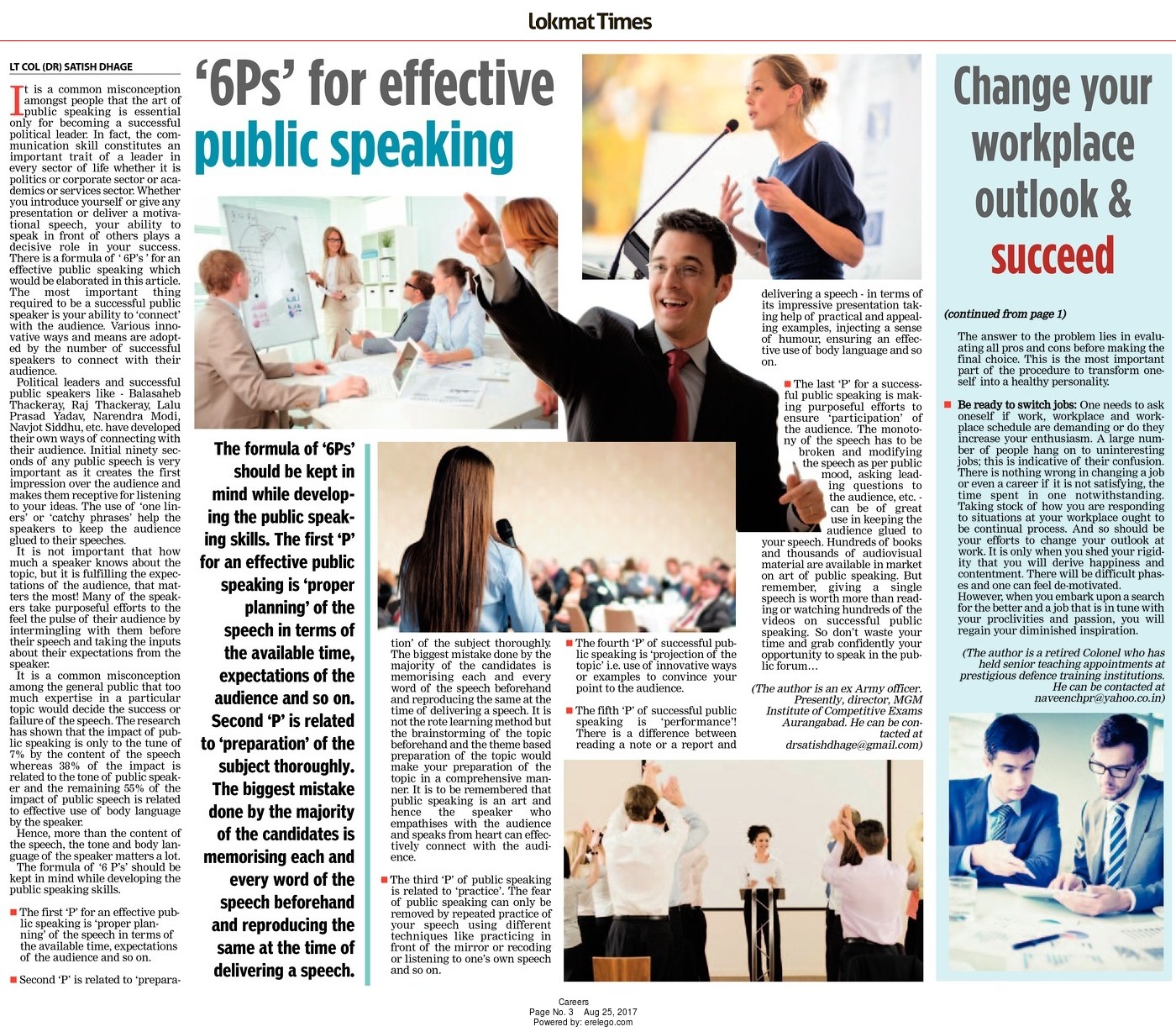Formula of ‘ 6P’s ’ for Effective Public Speaking
It is a common misconception amongst people that the art of public speaking is essential only for becoming a successful political leader. In fact, the communication skill constitutes an important trait of a leader in every sector of life whether it is politics or corporate sector or academics or services sector. Whether you introduce yourself or give any presentation or deliver a motivational speech, your ability to speak in front of others plays a decisive role in your success. There is a formula of ‘ 6P’s ’ for an effective public speaking which would be elaborated in this article.
The most important thing required to be a successful public speaker is your ability to ‘connect’ with the audience. Various innovative ways and means are adopted by the number of successful speakers to connect with their audience. Political leaders and successful public speakers like – Balasaheb Thackeray, Raj Thackeray, Lalu Prasad Yadav, Narendra Modi, Navjot Siddhu, etc. have developed their own ways of connecting with their audience. Initial ninety seconds of any public speech is very important as it creates the first impression over the audience and makes them receptive for listening to your ideas. The use of ‘one liners’ or ‘catchy phrases’ help the speakers to keep the audience glued to their speeches. It is not important that how much a speaker knows about the topic, but it is fulfilling the expectations of the audience, that matters the most! Many of the speakers take purposeful efforts to the feel the pulse of their audience by intermingling with them before their speech and taking the inputs about their expectations from the speaker. It is a common misconception among the general public that too much expertise in a particular topic would decide the success or failure of the speech. The research has shown that the impact of public speaking is only to the tune of 7% by the content of the speech whereas 38% of the impact is related to the tone of public speaker and the remaining 55% of the impact of public speech is related to effective use of body language by the speaker. Hence, more than the content of the speech, the tone and body language of the speaker matters a lot.
 The formula of ‘6 P’s’ should be kept in mind while developing the public speaking skills. The first ‘P’ for an effective public speaking is ‘proper planning’ of the speech in terms of the available time, expectations of the audience and so on. Second ‘P’ is related to ‘preparation’ of the subject thoroughly. The biggest mistake done by the majority of the candidates is memorising each and every word of the speech beforehand and reproducing the same at the time of delivering a speech. It is not the rote learning method but the brainstorming of the topic beforehand and the theme based preparation of the topic would make your preparation of the topic in a comprehensive manner. It is to be remembered that public speaking is an art and hence the speaker who empathises with the audience and speaks from heart can effectively connect with the audience. The third ‘P’ of public speaking is related to ‘practice’. The fear of public speaking can only be removed by repeated practice of your speech using different techniques like practicing in front of the mirror or recoding or listening to one’s own speech and so on. The fourth ‘P’ of successful public speaking is ‘projection of the topic’ i.e. use of innovative ways or examples to convince your point to the audience. The fifth ‘P’ of successful public speaking is ‘performance’! There is a difference between reading a note or a report and delivering a speech – in terms of its impressive presentation taking help of practical and appealing examples, injecting a sense of humour, ensuring an effective use of body language and so on. The last ‘P’ for a successful public speaking is making purposeful efforts to ensure ‘participation’ of the audience. The monotony of the speech has to be broken and modifying the speech as per public mood, asking leading questions to the audience, etc. – can be of great use in keeping the audience glued to your speech.
The formula of ‘6 P’s’ should be kept in mind while developing the public speaking skills. The first ‘P’ for an effective public speaking is ‘proper planning’ of the speech in terms of the available time, expectations of the audience and so on. Second ‘P’ is related to ‘preparation’ of the subject thoroughly. The biggest mistake done by the majority of the candidates is memorising each and every word of the speech beforehand and reproducing the same at the time of delivering a speech. It is not the rote learning method but the brainstorming of the topic beforehand and the theme based preparation of the topic would make your preparation of the topic in a comprehensive manner. It is to be remembered that public speaking is an art and hence the speaker who empathises with the audience and speaks from heart can effectively connect with the audience. The third ‘P’ of public speaking is related to ‘practice’. The fear of public speaking can only be removed by repeated practice of your speech using different techniques like practicing in front of the mirror or recoding or listening to one’s own speech and so on. The fourth ‘P’ of successful public speaking is ‘projection of the topic’ i.e. use of innovative ways or examples to convince your point to the audience. The fifth ‘P’ of successful public speaking is ‘performance’! There is a difference between reading a note or a report and delivering a speech – in terms of its impressive presentation taking help of practical and appealing examples, injecting a sense of humour, ensuring an effective use of body language and so on. The last ‘P’ for a successful public speaking is making purposeful efforts to ensure ‘participation’ of the audience. The monotony of the speech has to be broken and modifying the speech as per public mood, asking leading questions to the audience, etc. – can be of great use in keeping the audience glued to your speech.
Hundreds of books and thousands of audiovisual material are available in market on art of public speaking. But remember, giving a single speech is worth more than reading or watching hundreds of the videos on successful public speaking. So don’t waste your time and grab confidently your opportunity to speak in the public forum…
(The author of this article ,Lt Col (Dr) Satish Dhage, is an ex Army officer and has been qualified for IPS (Indian Police Services) through IPS LCE 2012. Presently, he is Director, MGM Institute of Competitive Exams Aurangabad. For any queries or feedback, he can be contacted on email id : drsatishdhage@gmail.com)



